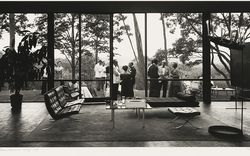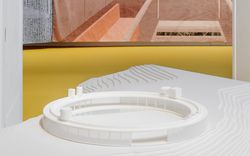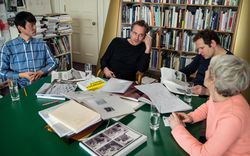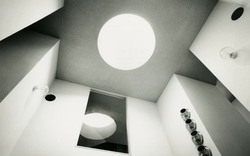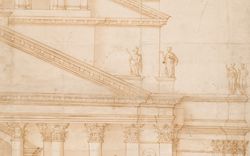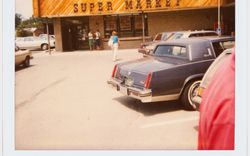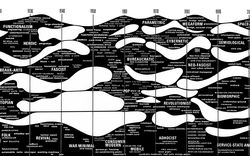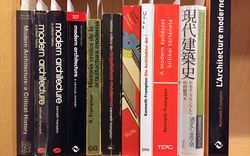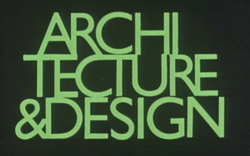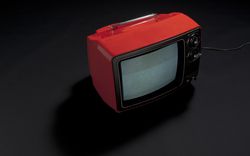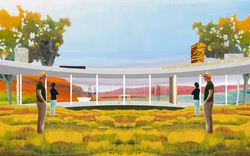A Conversation Around the Avant-Garde
Philip Johnson answers Jeff Kipnis
- PJ
- I must thank Phyllis Lambert for her kind introduction and congratulate her for her remarkable account of a major episode in the introduction of the avant-garde to the States. Of course, what stands as research material for Phyllis—all those names, dates, and locations—are, for me, memories. As I listened, her remarks felt to me like the teary-eyed beginning of an episode of This is Your Life, while to most in the audience, they must have seemed dry, obscure scholarship.
In any case, our subject tonight is the avant-garde. Now, I am not a scholar, not a historian, not an expert on the avant-garde as are many in the audience. Unlike them, I just happen to have been there when it happened, or at least when it got to the States. Now, that small advantage entitles me to a status that I have always yearned for, but that, until now, has eluded me. Because I was there, I can talk about things the experts do not know anything about, and they do not dare contradict me, whether I am right or wrong!
At one point, Phyllis mentioned the late Lincoln Kirstein, founder of the New York City Ballet and my lifelong friend. Lincoln once said that he thought the greatest catastrophe of twentieth-century culture was Alfred Barr, who, he believed, killed the authentic spirit of the culture by making it an emblem of money and society. Now, Barr, Jere Abbott, Chick Austin, myself, and a few others thought of ourselves as ardent enthusiasts, as sponsors of the avant-garde. We were proud to be avant-gardists; we wore our enthusiasm as a badge of honour that distinguished us as culturally superior to those around us.
In fact, we did not have the slightest idea what the avant-garde was. Nobody told us it was an intellectual and artistic movement devoted to revolution. I did not learn that it began with Baudelaire until the other night. At the Museum of Modern Art, we were ignorant of the political dimension of the art; for us it was revolutionary, but only aesthetically. Our job as we saw it was to advocate, to sell these new cultural innovations to the wealthy and powerful, to the Rockefellers and others. I must say that, if naive, our enthusiasm for the avant-garde was nevertheless real; we loved it, we never thought of ourselves as servants of the market system, the very system the work opposed. Though, of course, we were. - JK
- Today, as I mulled over this conference and our conversation, it hit me that what you and I have in common in this context is that both of us are profiteers on the avant-garde. Our friends and colleagues do experimental work, they tear their hair out and they sell their souls for it, then you and I package it and sell it. You to your corporate clients and I to my students and readers. Now, it seems you are saying that Alfred Barr was the same, that he and his friends from Harvard came to New York and commodified the avant-garde.
- PJ
- Yes, that is my point. We killed the avant-garde by making it a garde. The avant-garde cannot exist if it is a garde; it cannot exist apart from comedians and mountebanks and poets; it cannot thrive as a hobby of the bourgeoisie.
Read more
- JK
- Why do you think it was such a popular product? I mean, why do you think it worked so well in the social and the intellectual circles of New York? Why did an idea of the avant-garde and certain samples of painting and architecture enable such an institution as the Museum of Modern Art? What was it that fascinated everyone about the avant-garde?
- PJ
- I hope you can answer your own questions, because I cannot. All of us were convinced that we were inventing a new world. For us, the term avant-garde was a blanket term for anything new and different. But why our efforts were so successful—I have no idea.
- JK
- Was it possible that in your hands the avant-garde turned into fashion?
- PJ
- Yes, and in keeping with that idea, it is important to note that we tended toward safer work. I loved Klee, who at that time was not much appreciated, particularly at Harvard. But actually there was nothing very difficult about his work. So we were lucky. We could call our interests avant-garde and pride ourselves on our cutting edge tastes and still play it safe. We knew damn well that established figures such as Cézanne and Degas were rather good painters, you see. But there was not such a gap between those established painters and the so-called radical work we admired.
Alfred Barr took great pride when none of the faculty at Harvard were able to comment on his thesis on Picasso. They simply did not know who Picasso was! Nevertheless, even at the time, Picasso was a fairly safe bet. And after all, these figures had already been introduced to the U.S. at the Armory show, at Stieglitz’s gallery, and elsewhere. We just brought them to new circles, first to academia, then to New York society. - JK
- Was it your idea to extend the search for the avant-garde to architecture?
- PJ
- No, it was Alfred’s. He included architecture, film, the theater, every facet of the unfolding of modernity. I knew nothing about architecture at all. He said to me, “That’s all right, Philip, you will.” And he was right.
- JK
- He sent you to Dessau?
- PJ
- Yes. Barr was fascinated by the Bauhaus, which he considered the first avant-garde institution in the world.
- JK
- And upon arriving there did you detect a revolutionary sensibility?
- PJ
- What a dumb question. When I arrived, I met amazing people, geniuses, and saw incredible work. I was intoxicated, overwhelmed. I did not “detect” anything. In fact, though I loved what I saw, I did not understand any of it, particularly in polemical terms. Sure, everyone at the Bauhaus, everyone everywhere at the time, the Germans, Corb, everyone argued that modern art and architecture would make the world a better place, that, so to speak, one would become a better person living in a glass house. I can testify it ain’t true.
- JK
- Really? I thought you would testify that it was true.
- PJ
- I wish. But it did not improve my temper, my thoughts and opinions, or my sense of social responsibility. All it did was make me more famous. Even if there were a social or political revolutionary zeal associated with the avant-garde at the Bauhaus, I do not think I ever cared about it. Or let me put it this way: I always thought the visual revolution was more interesting and infinitely more important.
- JK
- It seems to me that there is an irresolvable conflict in the structure of any avant-garde. On the one hand, it must embrace in some sense the forces of disestablishment, mechanization, markets, etc., i.e., the forces that overturn traditional forms of authority. On the other hand, a true avant-garde must propose new forms of authority that resist those same forces.
- PJ
- That’s right.
- JK
- And therefore, an avant-gardist is trapped in the conflict of having to associate with disestablishment and resist it at the same time.
- PJ
- I understand your point; that is why there is no longer any authentic avant-garde. But at the time, that conflict posed no difficulty for us. Alfred Barr firmly believed that virtue was on his side, and therefore that God was on his side. It helped to have God working with you. So that apparent contradiction was swept aside along with everything else in Barr’s way.
By a stroke of luck, Alfred met the Rockefellers and started the Museum of Modern Art from nothing. I mean, talk about luck. To find somebody willing and able to finance such a wild idea as the Museum of Modern Art, to give it blue-ribbon authority, to turn it into a propaganda machine. It was opportunity given to very few and successfully carried out by fewer still. In some sense, the history of the avant-garde in the U.S. is a history of Barr’s ego, his will.
It felt to all of us as if we had a calling. One must remember that Alfred was a preacher’s son, and I was a Calvinist at heart. Such fervent devotion and commitment to improvement was in the American grain. For us, art was perfect. It was a virtue, just like religion. And we were the elect. - JK
- How would you compare that sensibility to attitudes today?
- PJ
- Well, my answer is very simple. Today, there is no such thing as the avant-garde; it is not even a possibility. The Duchamps and the Kieslers ended a long line of sincere revolutionaries. Duchamp kept his last works secret, and Kiesler, today a mere footnote, spent much of his energy attacking us at the museum. These were the last true spirits of the avant-garde, the last true revolutionaries. But you see, the true avant-garde is never very good at selling things.
- JK
- You are talking about a dialectical avant-garde, a revolutionary avant-garde that is seeking to overturn one authority and replace it with a new authority.
- PJ
- Yes, that is the only true avant-garde.
- JK
- There are those who claim to represent a new, contemporary avant-garde. But these artists operate very differently. They do not seek to overturn dominant practices and institutions; rather, they seek to infiltrate and destabilize them. You have been implicated in such efforts in architecture, by organizing the deconstructivist show and by your patronage of certain kinds of architecture, even experimenting with their ideas in your own work.
- PJ
- I never was a member of the avant-garde. I was always a member of the upper class, a bourgeois if there ever was one, and content as such. No, I am just addicted to the new; it helps me fight the interminable boredom of bourgeois culture. Robert Hughes and Harold Rosenberg were right, the avant-garde gave way to the shock of the new, to the tradition of the new. Some critics call my fascination with new architecture flippant, lightweight. I get the point. But it just expresses my desire to be different, to see different things and yet to stay perfectly centred within the system. I am not out to change anything. I am just fighting off boredom.
For instance, I have just built that crazy building out in the country, the Gate House, you know the red one that goes waving in the breeze? The building is entirely rear-garde, hearkening back to German expressionism. But to me it is something novel. What was the avant-garde has become a frantic search for novelty. - JK
- When we say the avant-garde is dead and all we have left is fashion, we imply that fashion is without substance, a trivial and destitute consequence of commodification lacking the depth of a true avant-garde. I think differently. I think we should revisit the question of fashion with the same respect that we pay the question of the avant-garde. To state it more forcefully, I think that the arts as a historicized cultural practice have never been anything other than fashions. The problem, therefore, is not the loss of the depth of the avant-garde, but the failure to recognize that that illusion of depth merely disguised the mechanisms of fashion. If it is true that the avant-garde is dead, then what provides the impetus for novelty, or for any resistance to dominant modes of practice?
- PJ
- A desire to be famous, and a hatred of boredom. Period.
This conversation was first published by The Monacelli Press in our 1997 book Autonomy and Ideology: Positioning an Avant-garde in America, the record of a conference organized by Phyllis Lambert and Peter Eisenman to celebrate the ninetieth birthday of Philip Johnson.
